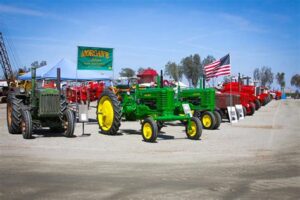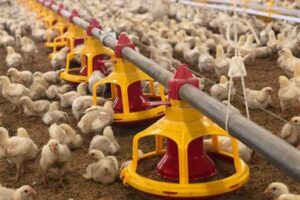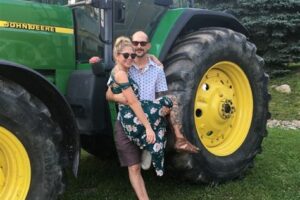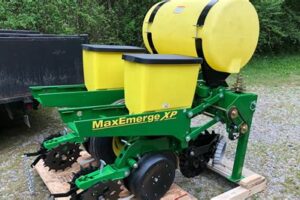Table of Contents
Looking for a comprehensive list of farm equipment? Explore our collection of essential tools and machinery designed to streamline farming operations. From tractors and harvesters to irrigation systems and livestock handling equipment, discover the necessary tools to enhance productivity and efficiency on your farm.
In the world of agriculture, having the right equipment can make all the difference. From tilling the soil to harvesting the crops, farmers rely on a variety of tools and machinery to efficiently manage their land. But with so many options available, it can be overwhelming to determine which equipment is essential for a successful farming operation. That’s why we have compiled a comprehensive list of farm equipment that every farmer should consider investing in. Whether you are starting a small-scale farm or managing a large agricultural enterprise, our list will help you navigate the vast array of machinery and tools available, ensuring that you have everything you need to maximize productivity and yield.
Introduction
In the world of modern agriculture, farmers heavily rely on various types of equipment to efficiently carry out their tasks. From planting seeds to harvesting crops, these machines have revolutionized the farming industry, increasing productivity and reducing labor. In this article, we will explore a comprehensive list of farm equipment that plays a vital role in the day-to-day operations of a farm.
Tractors
One of the most essential pieces of farm equipment is the tractor. Tractors are versatile machines used for various tasks such as plowing, tilling, planting, and hauling. They come in different sizes and power capacities, with a wide range of attachments available for specific needs.
Combine Harvesters
Combine harvesters, often referred to as combines, are designed to efficiently harvest grain crops. These machines are capable of cutting, threshing, and separating the grain from the crop, significantly reducing the time and effort required for manual harvesting.
Plows
Plows are used for primary tillage, breaking up the soil and turning it over to prepare it for planting. They come in various designs, such as moldboard plows, disk plows, and chisel plows, each suited for different soil types and conditions.
Seeders
Seeders are machines used to sow seeds into the prepared soil. They evenly distribute seeds at the desired depth and spacing, ensuring optimal germination and crop growth. Seeders can be manual or mechanical, with some models equipped with advanced technologies for precision planting.
Sprayers
Sprayers are essential for applying fertilizers, pesticides, and herbicides to crops. These machines ensure even coverage of chemicals, helping to control pests, diseases, and weeds. Sprayers can be mounted on tractors or operated separately, depending on the size of the farm.
Harrows
Harrows are used for secondary tillage, breaking up clumps of soil, leveling the surface, and preparing it for planting. They can also be used to incorporate fertilizers or other amendments into the soil. Harrows come in various types, including disc harrows, chain harrows, and tine harrows.
Balers
Balers are machines used to collect and compress crops such as hay or straw into compact bales for storage or transportation. They come in different sizes and can be operated manually or automatically, making the process of baling more efficient and convenient.
Spreaders
Spreaders are used to distribute fertilizers, lime, or seeds evenly across the field. These machines ensure precise application rates, preventing over or under-fertilization. Spreaders can be mounted on tractors or operated as standalone equipment.
Cultivators
Cultivators are used for weed control and soil aeration. They remove weeds by shallowly digging the soil around the crops, uprooting unwanted plants without damaging the desired crops. Cultivators can be drawn by tractors or operated manually.
Hay Rakes
Hay rakes are used to gather and arrange hay or straw into windrows for drying or baling. These machines help speed up the drying process by exposing the crop to sunlight and allowing air circulation. Hay rakes can be operated manually or attached to tractors.
Conclusion
These are just a few examples of the extensive list of farm equipment that farmers rely on to efficiently manage their operations. Each machine serves a specific purpose, contributing to increased productivity and reduced labor on the farm. As technology continues to advance, we can expect further innovations in farm equipment, making farming more efficient and sustainable in the future.
List of Farm Equipment
Farming is a complex and demanding task that requires the use of specialized equipment to ensure efficient operations and maximize agricultural productivity. From tractors to harvesters and irrigation systems, each piece of farm equipment plays a crucial role in different stages of farming. This article provides an overview of some of the essential farm equipment used in modern agricultural practices.
1. Tractors
Tractors are the backbone of any farm operation, serving multiple purposes throughout the farming process. These versatile machines are equipped with powerful engines and advanced technologies to plow fields, till soil, plant crops, and pull attachments or trailers. Tractors come in various sizes and power capacities, allowing farmers to choose the most suitable option for their specific needs. With their efficiency and productivity-enhancing features, tractors have revolutionized farming practices worldwide.
2. Harvesters
Harvesters are specialized machines designed to efficiently harvest a wide range of crops, including grains, fruits, and vegetables. These machines employ cutting, threshing, and separating mechanisms to collect and process crops in large quantities. Advanced models offer features such as grain monitoring systems, adjustable cutting heights, and GPS navigation for precise crop yield estimation and control. Harvesters play a vital role in crop production, ensuring timely and efficient harvesting while minimizing labor requirements.
3. Seed Drills
Seed drills are essential for precise and uniform seed placement in prepared soil. These machines accurately sow seeds at the desired depth and spacing, optimizing seed distribution and crop emergence. Seed drills come in various types, including pneumatic, mechanical, and precision drills, catering to different farming needs and crop varieties. By ensuring proper seed placement, seed drills contribute to higher crop yields and reduced seed wastage.
4. Sprayers
Sprayers are crucial for crop protection, as they effectively apply pesticides, herbicides, and fertilizers to control pests, diseases, and weeds. These machines distribute the chemicals in a controlled and uniform manner over crops, maximizing their effectiveness while minimizing wastage. Modern sprayers feature advanced technologies such as GPS guidance systems and auto-boom height control, ensuring precise and efficient application. Sprayers play a vital role in maintaining crop health and reducing crop losses due to pests and diseases.
5. Plows
Plows have been used for centuries to prepare the soil for planting by turning it over, burying crop residues, and breaking up compacted soil. These machines come in various designs, such as moldboard plows, chisel plows, and disk plows, each suited for different soil types and field conditions. Plowing helps improve soil structure, enhances nutrient availability, and creates an optimal seedbed for optimal crop growth. Plows have significantly contributed to the development of modern farming practices, enhancing soil fertility and overall crop productivity.
6. Balers
Balers are farm equipment used to compress and bind hay, straw, or other forage materials into compact bales for easy storage and transportation. These machines play a crucial role in the livestock industry, providing feed during periods of low forage availability. Balers come in different types, including round, square, and rectangular balers, allowing farmers to choose the most suitable method based on their needs and available resources. Balers have revolutionized the way forage materials are stored and utilized, contributing to improved livestock management and reduced feed wastage.
7. Combine Harvesters
Combine harvesters, often simply called combines, perform the combined tasks of cutting, threshing, and cleaning crops during the harvesting process. These machines streamline the harvesting process by efficiently harvesting and separating grain crops from the plant, reducing labor and time requirements. Combines are equipped with various attachments and features for harvesting different crops, making them highly versatile and indispensable in modern farming. Combine harvesters have greatly increased harvesting efficiency and have played a significant role in meeting the growing demands of the global population.
8. Irrigation Systems
Irrigation systems are essential farm equipment used to provide controlled water supply to crops, ensuring optimal growth and productivity. These systems deliver water directly to the root zone of plants, minimizing water wastage and preventing water stress. Different types of irrigation systems, such as sprinklers, drip irrigation, and center pivots, cater to different crop types, field sizes, and water sources, helping farmers maximize water efficiency and crop yields. Irrigation systems have revolutionized agriculture by enabling farmers to cultivate crops in areas with limited rainfall and ensuring consistent water availability for optimal crop growth.
In conclusion, the list of farm equipment mentioned above highlights some of the essential tools utilized in modern farming practices. These machines have significantly contributed to increasing agricultural productivity, improving crop quality, and enhancing overall farm efficiency. As technology continues to advance, the agriculture industry can expect further innovations and improvements in farm equipment, allowing farmers to meet the challenges of feeding a growing global population.
In the agricultural industry, having the right farm equipment is essential for efficient and effective farming operations. Whether you are a small-scale farmer or a large commercial farm, investing in high-quality farm equipment can significantly improve productivity and yield.
Here is a list of essential farm equipment that every farmer should consider:
- Tractors: Tractors are the backbone of any farm. They are versatile machines that can be used for plowing, tilling, planting, harvesting, and transportation. With various attachments and implements, tractors can handle a wide range of tasks, making them an indispensable tool for modern farming.
- Harvesting Equipment: Harvesting equipment such as combine harvesters, grain carts, and forage harvesters are designed to efficiently gather crops from the fields. These machines reduce manual labor and ensure faster and more accurate harvesting, leading to increased productivity and reduced losses.
- Planting Equipment: Planting equipment, including seed drills and planters, help farmers sow seeds with precision and uniformity. These machines not only save time and effort but also enable proper spacing and depth, resulting in better crop establishment and higher yields.
- Tillage Equipment: Tillage equipment like plows, cultivators, and harrows are essential for preparing the soil before planting. They help break up compacted soil, control weeds, and incorporate organic matter, creating an ideal seedbed for optimal crop growth.
- Irrigation Equipment: Irrigation systems, such as sprinklers, drip irrigation, and center pivots, are crucial for supplying water to crops during dry periods. They ensure consistent moisture levels, preventing drought stress and promoting healthy plant growth.
- Fertilizer and Chemical Applicators: Fertilizer spreaders and sprayers are used to apply fertilizers, herbicides, and pesticides to crops. These machines ensure accurate and even distribution, minimizing wastage and maximizing the effectiveness of inputs.
- Haying Equipment: Haying equipment like balers and hay rakes are utilized for harvesting and baling hay or forage crops. These machines enable efficient handling and storage of fodder, which is crucial for livestock feed and maintaining farm sustainability.
- Livestock Handling Equipment: Livestock handling equipment, such as corral systems, chutes, and squeeze gates, are essential for safely managing and handling animals. These tools help reduce stress on livestock and enhance overall farm efficiency.
- Storage and Handling Equipment: Grain bins, silos, elevators, and conveyors are used for storing, handling, and transporting harvested crops. These facilities and equipment protect crops from spoilage, pests, and moisture, ensuring their quality and market value.
- Power Tools and Small Equipment: Various power tools and small equipment, including chainsaws, trimmers, and portable generators, are necessary for general maintenance, repairs, and other specific tasks around the farm.
It is important to note that the specific farm equipment needed may vary depending on the type of farming operation, crop selection, and farm size. Investing in reliable and well-maintained equipment can result in significant cost savings, increased productivity, and improved profitability in the long run.
Thank you for visiting our blog and taking the time to learn more about the list of farm equipment. We hope that this article has provided you with valuable insights and information about the various types of equipment used in modern-day farming. As professionals in the field, we understand the importance of having the right tools and machinery to optimize productivity and efficiency on the farm.
Throughout this article, we have highlighted some of the essential farm equipment that every farmer should consider investing in. From tractors and harvesters to irrigation systems and livestock handling equipment, each piece plays a crucial role in ensuring the success and profitability of a farming operation. By providing a comprehensive overview of these tools, we aim to assist both experienced farmers and those new to the industry in making informed decisions about the equipment they need.
Transitioning from traditional farming methods to utilizing modern technology and equipment can significantly enhance productivity and streamline operations. It is important to carefully assess your specific needs and the requirements of your farm when selecting the right equipment. Consider factors such as the size of your farm, the type of crops or livestock you manage, and your budget. Investing in quality equipment may require a significant upfront cost, but the long-term benefits in terms of increased efficiency and reduced labor can far outweigh the initial investment.
In conclusion, having access to the right farm equipment is vital for any agricultural enterprise. Whether you are a large-scale farmer or a small-scale producer, having the appropriate tools can make a world of difference to your productivity and overall success. We hope that this article has been informative and has given you a better understanding of the different types of equipment available in the market today. Remember, choosing the right equipment for your farm is a decision that should be made with careful consideration and expert advice.
Thank you once again for visiting our blog, and we encourage you to explore our other articles for more valuable insights and information about the world of farming and agriculture. Should you have any further questions or require additional guidance, please do not hesitate to reach out to us. Wishing you all the best in your farming endeavors!
Video List Of Farm Equipment
People also ask about List of Farm Equipment:
What are the essential farm equipment?
Essential farm equipment includes:
- Tractors
- Harvesters
- Plows
- Seeders
- Cultivators
- Sprayers
- Mowers
- Balers
- Spreaders
- Handlers (for livestock)
What are the different types of agricultural machinery?
Different types of agricultural machinery include:
- Tractors
- Combine harvesters
- Balers
- Plows
- Seeders
- Cultivators
- Sprayers
- Harrows
- Spreaders
- Threshers
- Mowers
- Loaders
- Handlers (for livestock)
What equipment is used in crop production?
Equipment used in crop production includes:
- Tractors
- Plows
- Seed drills
- Cultivators
- Sprayers
- Harvesters
- Balers
- Spreaders
- Irrigation systems
- Greenhouses
What are the tools used in animal farming?
Tools used in animal farming include:
- Handlers (for livestock)
- Milking machines
- Shearing machines
- Fencing equipment
- Feeders and waterers
- Egg incubators
- Veterinary instruments
- Animal identification tags
- Animal trailers
- Animal scales
What are the safety measures while using farm equipment?
It is important to follow these safety measures while using farm equipment:
- Read and understand the equipment’s user manual.
- Wear appropriate protective gear, such as helmets, gloves, and goggles.
- Ensure proper training and certification for equipment operation.
- Maintain the equipment regularly to prevent malfunctions.
- Keep a safe distance from moving parts and maintain visibility.
- Be cautious of electrical hazards and use grounded outlets.
- Store equipment properly and securely when not in use.
- Operate machinery only when well-rested and alert.
- Follow all traffic rules and signals when using equipment on roads.
Remember to consult the specific user manuals and guidelines provided by manufacturers for detailed information regarding the operation, maintenance, and safety of each farm equipment.






